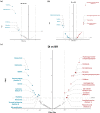Chronometabolism: The Timing of the Consumption of Meals Has a Greater Influence Than Glycemic Index (GI) on the Postprandial Metabolome
- PMID: 37110149
- PMCID: PMC10143625
- DOI: 10.3390/metabo13040490
Chronometabolism: The Timing of the Consumption of Meals Has a Greater Influence Than Glycemic Index (GI) on the Postprandial Metabolome
Abstract
Eating late in the day is associated with circadian desynchrony, resulting in dysregulated metabolism and increased cardiometabolic disease risk. However, the underlying mechanisms remain unclear. Using targeted metabolomics of postprandial plasma samples from a secondary analysis of a randomised 2 × 2 crossover study in 36 healthy older Chinese adults, we have compared postprandial metabolic responses between high (HI) glycemic index (GI) or low-GI (LO) meals, consumed either at breakfast (BR) or at dinner (DI). 29 out of 234 plasma metabolites exhibited significant differences (p < 0.05) in postprandial AUC between BR and DI sessions, whereas only five metabolites were significantly different between HI and LO sessions. There were no significant interactions between intake timing and meal GI. Lower glutamine: glutamate ratio, lower lysine and higher trimethyllysine (TML) levels were found during DI compared with BR, along with greater postprandial reductions (δAUC) in creatine and ornithine levels during DI, indicating a worse metabolic state during the evening DI period. Greater reductions (δAUC) in postprandial creatine and ornithine were also observed during HI compared with LO (both p < 0.05). These metabolomic changes may indicate potential molecular signatures and/or pathways linking metabolic responses with cardiometabolic disease risk between different meal intake timings and/or meals with variable GI.
Keywords: cardiometabolic disease risk; glucose homeostasis; glycemic index; metabolomics; timing of meal intake.
Conflict of interest statement
The authors declare no conflict of interest.
Figures


References
Grants and funding
LinkOut - more resources
Full Text Sources

